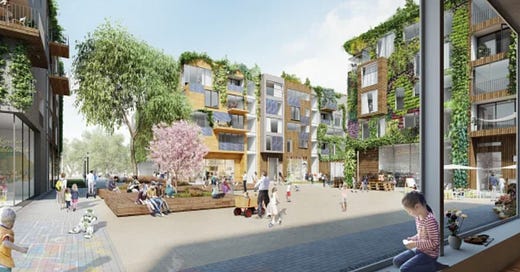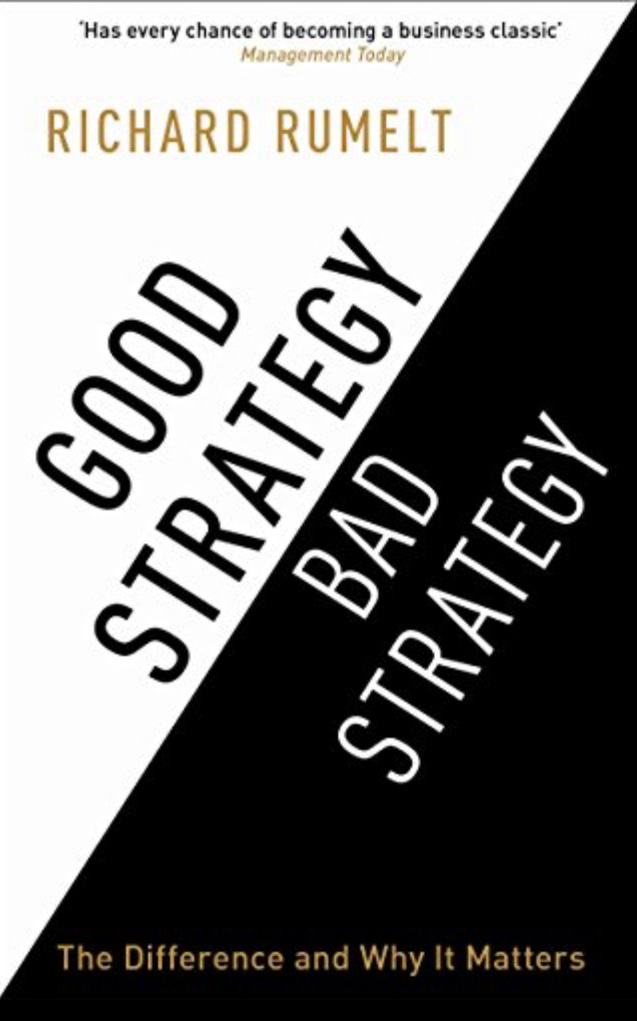21 July 2022. Climate | Strategy
We can build climate friendly neighbourhoods, if we want to. // Thinking about strategy
Welcome to Just Two Things, which I try to publish daily, five days a week. Some links may also appear on my blog from time to time. Links to the main articles are in cross-heads as well as the story. A reminder that if you don’t see Just Two Things in your inbox, it might have been routed to your spam filter.
1: We can build climate friendly neighbourhoods, if we want to
It’s been a terrible week for climate news, so it’s refreshing to read that people are still trying. My colleague Johann Schutte sent me a piece from Fast Company on the repurposing of Berlin’s now-disused Tegel Airport as a kind of regenerative neighbourhood.
The terminal buildings are being refitted as offices and research hubs. But much of the airfield is being turned in a 5,000 new homes, designed with the climate in mind:
“The planning is based on questions such as: How do we want to live and get around in urban spaces in the future? What qualities are important to us as individuals and as a community? And what functionalities can’t we do without?” explains Constanze Döll, press secretary for the Tegel Projekt.
The design hasn’t been finalised yet, but there are some design principles in place. The most important of these is people before cars:
“The Schumacher Quartier is planned in such a way that the streets and squares belong to the people again, rather than to cars,” Döll says. “We want to let people rediscover the public space . . . for socializing, playgrounds, places to relax and talk. Important locations in the neighborhood, like the kindergarten, school, bakery, supermarket, can be reached easily by foot.”
That also means good access for bikes, but not for cars: the area will be mostly car-free.
The apartments are being built from wood, partly because of its property as a carbon store, and when completed it will be the biggest wood-built neighbourhood in the world. This will also reduce construction emissions by 80%:
The designs will also be ultra-efficient, and all energy will be produced on the site, including solar and geothermal power. A system will also harvest waste heat from adjacent commercial buildings to heat the homes.
It’s also being designed to be ‘spongy’ and capture water from, say, extreme rainfalls.
“All rainwater is used or stored in the quarter; nothing is lost,” Döll says. “If the water evaporates on hot days, it cools the surrounding area—and if instead it seeps in, it fills up the groundwater. This self-contained system makes for local climate regulation, aided by many large-leaved, deciduous trees that act like natural air-conditioning systems.”
Just to add to the design criteria, it’s also going to be designed to support biodiversity, through the design of both buildings and open spaces.
Here’s a nice picture of what it’s supposed to look like:
(Image: (c) Tegel Projekt Gmbh)
The intention is that the start-ups will be focused on the post-carbon economy, and that they will be able to use the area to test prototypes and so on.
They’re still clearing the site, so haven’t started building yet. I’m hoping that by the time they do start building their good ecological principles haven’t been compromised by a different set of commercial calculations.
But what I take away from this is we know what we should and what we can do about climate change and biodiversity loss. When we look back, the tragedy will be that we chose not to do it.
By the way the whole area is to be called the Schumacher Quarter. It wasn’t clear from the article if is being named after the racing driver or the ecological economist.
Anyway, there’s there’s a glossy looking futuresy presentation about the project here.
2: Thinking about strategy
I’ve been doing some strategy work this week, which sent me back to Richard Rumelt’s book Good Strategy Bad Strategy, which is one of a handful of strategy books worth reading.
It’s a decade old now, but one of the reasons I like it is that he has a clear model of what strategy is, which I’m summarising here.
Good strategy, he says, is composed of a “kernel” of three elements (p77):
- A diagnosis that defines or explains the nature of the challenge. A good diagnosis simplifies the complexity by identifying the critical aspects of the situations.
- A guiding policy for dealing with the challenge.
- A set of coherent actions that are designed to carry out the guiding policy.
So, in effect, a strategic diagnosis is a model of the situation that allows you to act, and so of course, it comes in the general heading of ‘all models are wrong but some are useful’.
Specifically: a good diagnosis of a situation
should replace the overwhelming complexity of reality with a simpler story, a story that calls attention to its crucial aspects. This simplified model of reality allows one to make sense of the situation and engage in further problem solving.
So it’s doing two things. It is defining “a domain of action”, through a process of sense-making, and it’s also creating alignment around the nature of the problem. Because, for Rumelt, the difference between strategy and analysis is action.
But it’s also worth saying that when you’re operating in a messy or complex environment, and trying to make sense of signs of change around you, the diagnosis is likely to be unclear and also contested. Especially in large organisations, everyone will tend to think that the bit of the situation that they’re closest to is the reason why things are working less well than they used to. It can take time to create a shared understanding of the situation.
That’s all a bit abstract, but one of the examples he uses is of a local shop that is trying to compete with a 24/7 convenience store nearby. And the diagnosis becomes: what can I do well that they can’t do well?
Part of the catchment is ‘busy professionals’ who don’t have time to cook but want to eat well—and can afford to buy decent quality food. So in Rumelt’s example, that becomes the guiding policy: servicing people who are willing to trade money for time and quality.
And this then has some consequences for action. The range needs to change, and they can probably stop selling some of the range at the discount end of the market. These sorts of customers don’t want to hang around at the checkout, and might expect price to turn into decent service, so it is probably worth hiring someone to help on a second till in the busy period when the professional crowd is heading home.
He makes a distinction between a diagnosis that describes outcomes and one that creates the possibility of leverage over outcomes:
For instance, we know from research that K-12 student performance is better explained by social class and culture than by expenditures per student or class size, but that knowledge does not lead to many useful policy prescriptions.
He contrasts this with a diagnosis that he suggests creates an opening for action:
(Bill Ouchi’s) book Making Schools Work diagnoses the challenge of school performance as one of organization rather than as one of class, culture, funding, or curriculum design. Decentralized schools, he argues, perform better... What is critical, and what makes his diagnosis useful to policy makers, is that organization explains some part of school performance and that, unlike culture or social class, organization is something that can be addressed with policy.
Of course, we can argue about this, and it’s a good example of why framing the diagnosis is important. It matters whether we we are looking at student performance or school performance, for example. If you stick with a diagnosis about social class, for example, you might also conclude that actions that reduce the effects of inequality (such as a SureStart early years programme or an educational maintenance allowance that helps poorer children afford to stay in school) are also going to have an effect, although that then also depends on how patient you are going to be about your policy intervention. This makes it a decision for a politician or political party rather than—say—a head teacher or a school district supervisor.
Rumelt has a number of techniques that help to improve the changes of good strategy.
The first is using leverage. Leverage is identified through a mix of anticipation, insight into what is most pivotal, and the concentrated application of effort. It’s about where you need to address your effort. Anticipation brings foresight or futures into play, and may also involve a choice about which emerging trends you’re going to ally your business and business model to. (He uses the example of Toyota developing a hybrid vehicle strategy while American car companies doubled down on SUVs.)
A pivot point is an element that allows you to transform your insight value; it “magnifies the effect of effort.” And concentration is about choosing to focus resources on the points that make a difference. How do you know what makes a difference? Through the guiding principles.
The second element is the proximate objective, which is a short-to-medium term outcome that tells you you’re heading in the right direction. A good proximate objective also helps to resolve ambiguity by requiring the organisation to assess what it knows, and doesn’t know. It’s also a useful test of the strategy, because it’s hard to define a proximate objective for something that’s a slogan rather than a strategy (“the war on drugs”, say.)
A third element is about using design—meant here in the same sense in which John Kay uses “organisational architecture.” Design involves making plans, anticipating responses, and co-ordinating action: “Performance “is the joint outcome of capability and clever design.”
Rumelt has a new book out in hardback, although it’s hard to tell from the reviews if it’s a retread of Good Strategy Bad Strategy but with a spin that it’s for ‘leaders’. But I’ll definitely read it when it is out in paperback.
Notes from readers
My former colleague Walker Smith wasn’t a fan of my Monday post about Uber, and wrote to me to say so. He discussed Uber in his regular Four Tuesday column on LinkedIn. Here’s an extract:
Like any monopoly, taxicabs became insular and inefficient. As NYU law professor Katrina Wyman wrote in 2013 in the Yale Journal on Regulation, “New York taxicab licenses are an instance of inefficient private property rights sustained by political decision-making processes subject to pressures from powerful interest groups.” Read between the lines.
Uber showed what it takes—short of a determined political leader (e.g., Carter, Reagan, Thatcher)—to crack open an entrenched, government-sanctioned monopoly. Uber crossed some lines, but cab companies wear no halo. This has been a battle of titans, equally matched in resources, political access, and sharp elbows. Nor has either one been heaven-on-earth for drivers. Cab company drivers are not classified as employees either and they have been treated just as poorly if not more so. The beneficiaries of this price-fixing monopoly were cab company owners not drivers. Not consumers either.
j2t#348
If you are enjoying Just Two Things, please do send it on to a friend or colleague.




